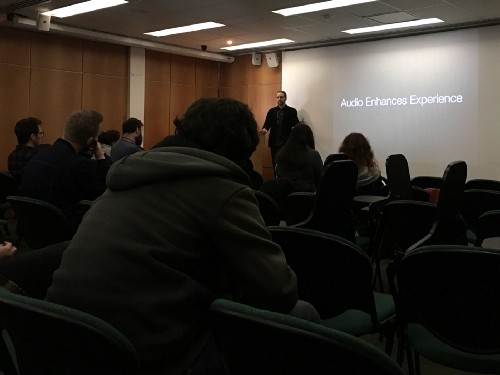Mark Angus, award winning Sound Designer, took time out of his busy schedule to talk to Behind the Glass. Known for his work on Harry Potter, Need for Speed, Alien:Isolation, Telling Lies and Fast and Furious Crossroads, we discuss his career and some of the challenges being experienced by game audio during the pandemic.
Angus made the transition to games from music after studying a post graduate degree in Post Production Sound at Bournemouth Media School. “I was privileged to get my start in the videogame industry at Electronic Arts, and worked for them in one form or another for a number of years” said Angus. “I’ve also worked for other major UK games studios, including Creative Assembly. About 6 years ago I decided to go freelance and set up Gladestock Studios, and have been working on games, TV and film projects for a number of clients since then.”
The games industry has changed significantly over the past few years. “We’ve come a long way as an industry since I started back in the Playstation 2 era, much of the challenge was about how to overcome the technical limitations of the platforms to achieve as high a quality a sound as possible” said Angus. “In the last 15 years or so both the development software and the games consoles have progressed so that we can reproduce sound on a par with Hollywood movies. The challenge has become to produce ever more immersive soundtracks that take advantage of the unique relationship we have with our audience, their interaction and control of the game experience. We’re moving forward into an era where technology such as Dolby Atmos is putting a new focus on 3d sound in the home environment. We’re uniquely suited to take advantage of that as we’ve been crafting 3D worlds for many years.”
As games are readily available on many different platforms, Angus needs to make sure that the mix works every time. “This is an area where we have some advantages over linear sound; the player can choose in-game options that allow us to tailor the mix for whatever platform they are experiencing on. We can affect the final mix through EQ, compression, limiting as well as real-time mixing the game differently depending on speaker type and setup; whether small stereo speakers on a phone or a large home cinema Dolby Atmos system.”
With games now telling more complex stories, we are seeing more cinematic aspects incorporated into their sound design. “We’ve had to learn and adapt from cinema as much as we could, in terms of asset creation, use of foley, use of surround, mixing, and adapt it all to the interactive medium” added Angus. “I watch a LOT of film and television, looking at how it is mixed, how the sound designers approach special effect sounds, and then reverse engineer that into a game environment. The production quality of top tier cinema is incredible (and usually with much larger budgets than us!) but as an industry I think we match and even surpass it in our interactive experiences.”
“Creating an atmospheric soundtrack has a lot to do with being able to deliver the right sort of audio for the different gameplay moments in a game. So when the action is hot, you need to be able to deliver bombastic sound effects and music. But when the player chooses to explore the game world, spending a lot more time in your soundscape than a film viewer would do, you have to have crafted enough variety, interest and immersive detail to keep them grounded in the game universe, and make them feel they are always a part of it. There are so many stories we can tell just in audio that can happen away from the gameplay and visuals.”
Angus has had some rather challenging projects to work on too. “I think creatively, the most challenging of recent years was Telling Lies. Sam Barlow’s games are a genre to themselves, neither a traditional video game nor a traditional TV/film experience. So the approach to every aspect of production is unusual. We were creating a living, breathing New York apartment that changes subtly around you as the hours of the game progress, and doing so with almost no visuals to support that. At the same time, we designed an interactive music system that had to deliver meaningful music in sync to video content that you could watch in any order, at any pace, stopping and scrubbing back and forth at will. The interface of composer, music system design and an amazing data system that tracked and anticipated the player’s cumulative experience of the game, it was something magical when it came together.”
As for creating sounds, Alien: Isolation presented Angus with some challenges. “We had to design a motion tracker that did something that it never had to do in the movies, actually work! What sounds good for 2 or 3 seconds on screen doesn’t necessarily work over hours and hours of gameplay, and doesn’t necessarily support the function of the object, such as tracking a moving Alien. The visual design and my audio design of that went through many changes, trying to nail something that both felt completely authentic to the movies, and made the game scarier. I think we succeeded!”
Like many, with the COVID- 9 pandemic and lockdown, the games sector has also been affected. “Major upcoming game releases have been pushed back and areas such as physical media production and distribution are severely affected” said Angus. “However, as a technology-based industry we’re extremely well set up for remote working, and distributed teams. I am part of the team with ‘Slightly Mad’ and they’ve been making games entirely remotely for over a decade with team members across all time zones. So they’ve very much taken this in their stride.”
The main challenges right now for audio are the lack of access to larger facilities for things like foley and dialogue recording, post mixing. “For people like me who already have home studio facilities, my work is nearly all remote, the actual day to day of sound effect creation and implementation has been able to continue. I think moving forward the games industry will embrace work-from-home much more comprehensively. It suits the sort of work-life balance that the industry tries to achieve. When I went freelance and set up my own facility, I was placing a bet that more audio work generally might be outsourced, with smaller in-house teams and a more contract/remote approach to sound. I think Covid-19 will only accelerate that.”
As for his home set up, Angus uses plug-ins, such as the Soundtoys Crystallizer which he finds great for making UI/menu sounds and fun effects. In terms of libraries he likes the Bluezone bespoke ones as he finds they have great recordings with depth and impact - he has used these a lot on Fast & Furious.
As for advice for up coming audio engineers who want to get into games, Angus says its important to understand the interactive challenges of game audio. “When I started, the Catch-22 was that you needed experience with games development tools, but couldn’t really do so unless you worked in games. Now you have major games engines like Unreal or Unity free to download, and audio middleware like Wwise also free to experiment with. A smart showreel only goes so far, if you can show you understand the interactive challenges and have got your hands dirty with industry tools, you’ll be at a distinct advantage.”








